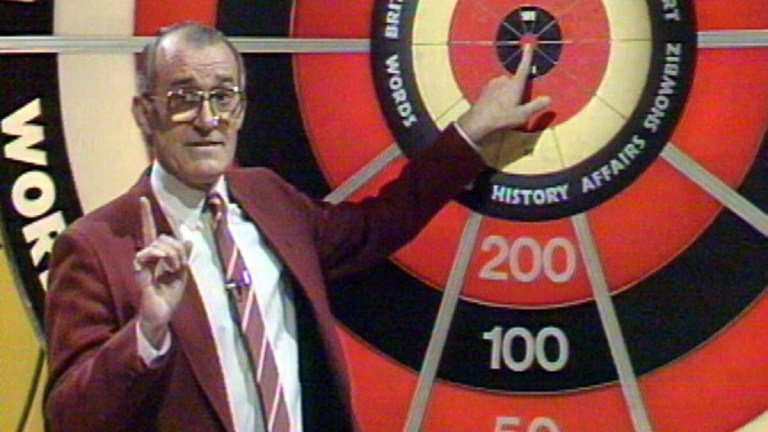The Prizes on Bullseye Had to Be Rubbish By Law
All those cutlery and decanter sets make sense now.

The gag about Bullseye is always the speedboat. How many contestants in the ITV darts-based game show that originally ran from 1981 – 1995, had room in their life or garage for occasional Star Prize, the speedboat? (Bullseye presenter Jim Bowen’s 2012 joke to The Mirror that “the only contestants who ever won them lived in top floor flats in Coventry” was taken literally by The Coventry Telegraph who in 2021 launched a local winners search that is presumably ongoing.)
The Bullseye speedboat was its prize anomaly, a symbol of glamour and excitement in a sea of hostess trolleys, sheepskin coats and stainless steel cutlery. After the winning team of two had built their cash fund by answering trivia questions from dart-selected categories, they faced Bully’s Prize Board. There, they threw nine darts in an attempt to win eight prizes plus the bullseye special. Having done that, they had the option to gamble the lot for Bully’s Star Prize – an affordable British-made car, caravan, or yes, speedboat. To share.
To modern eyes, Bully’s Prize Board is a fascinating time capsule of Stuff People Coveted in the 1980s (weight benches, portable cassette players, hi-fi stereo sets, slow cookers) and Stuff That Barely Constitutes a Prize (a pen and pencil, some Highland cake in a hamper, a teddy bear dressed like a Beefeater). Outside of Richard Osman’s House of Games, you’d be hard pressed now to find a TV game show giving away a nest of coffee tables or an electric drill, making the Bullseye offering seem charmingly naff these days.
You’ll know all that if you watched at the time, or if you tune in to Freeview channel 48/Challenge, which does the lord’s work by airing four hours of Bullseye a day. What you might not know is that the ITV game show was subject to strict legal limits on the cash value of its weekly prizes. Its pen and pencil presentation sets or knitting needle collections weren’t stinginess, but sacrifices required to pay for more exciting prizes elsewhere – portable televisions, motor-scooters etc.
When ITV, the UK’s first commercial TV station, launched in 1955, it was subject to rulings by the Independent Television Authority. Following a host of TV quiz show prize scandals in 1950s America (including Twenty-One as documented in 1994 feature film Quiz Show, The $64,000 Question and Dotto), the ITA set a £1,000 limit (still a significant amount of money in those days – and now on BBC game shows, which are regulated differently) on the amount of cash that could be won on a commercial channel game show.
That amount gradually increased over the years, as the ITA was replaced in 1972 by the UK’s commercial radio-and-TV governing Independent Broadcasting Authority. Between 1989 and 1992, the IBA limited weekly winnings to no more than £5,000 per individual or a weekly total of £6,000.
The cash winnings (or equivalent in prizes) limit applied to all commercial TV game shows on ITV, Channel 4, and satellite channels until 1993. That meant Bullseye, The Price is Right, You Bet!, Play Your Cards Right, Blockbusters… even the Blind Date holiday for the winning couple, all had to keep to the same relatively conservative budgets.
Relatively conservative in comparison with now, when tens of thousands of pounds are regularly handed out on TV for knowing that Paris is in France or that Henry VIII had six wives. That all started 30 years ago when the anti-corruption game show prize limits were abolished. From January 1993, game shows on commercial channels (so, not the BBC), could give away as much cash or equivalent in prizes as they wished. That led to the arrival a few years later of Who Wants to Be a Millionaire?, which, just as the ITA and IBA had feared, was an enticing enough sum to lead to the return of the quiz show cheating scandal. They clearly should have stuck to speedboats.
